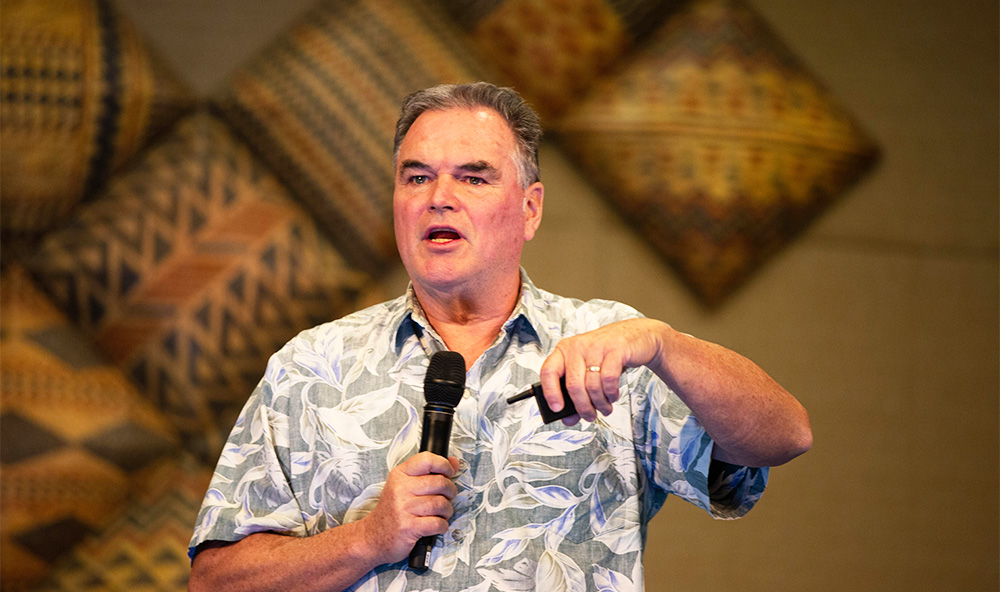Your conference business day recap
– WCRHCA Stronger Together

Innovation Alley presentations
- Mike Lenzie, Caterpillar Construction Technologies
- Dr. Ray Gallant, Volvo Construction Equipment
- Mark Wiese, McAsphalt
- Allan Cleiren, Fire & Flood
- Bob Vaughan, Bob Vaughan & Assoc.
9:15 am • Feb. 9
Our industry can be slow to adopt new things and we’re definitely behind others in adopting green tech and electric vehicles. But there’s a reason for that, notes Dr. Ray Gallant (Volvo Construction Equipment) and Mike Lenzie (Caterpillar Construction Technologies).
Both industry innovation specialists agreed that the move to green technology for heavy civil has been slow, by comparison, and will continue as such because of our unique needs. Those needs include moving very heavy equipment around sometimes long (and frigid) construction sites. Our machines don’t just transport, they are workhorses so reliability is vital.
Hence the longevity of the internal combustion engine powered by diesel, the fossil fuel a lot of people outside the industry love to hate.
But the reality is, Gallant said, we have to change to deliver on the imperatives of social, environmental and economic sustainability. Or, as he says, “people, planet, profits.”
At the moment, practical electric batteries are capable of delivering good energy density, but can’t keep a charge long enough for our needs.
The near future will see alternative fuels working in tandem with diesel to reduce the carbon footprint of the heavy construction industry. That will come in the form of new heavy equipment, including hybrids, operated or assisted by batteries.
And everyone’s talking about hydrogen, but Gallant sees the fuel cell not so much powering a machine, but working to charge the batteries that one day will power the machine.
Lenzie, meanwhile, says Caterpillar is delivering to market small and (soon) mid-sized heavy equipment that, depending on the where’s and what’s of your construction project, will work well.
But what he is most optimistic about is the power of autonomous technology to change the industry’s work and business plan. An autonomous excavator allows an operator of less experience and skill to move material from a road to a set grade, and then finishes up with greater precision to a final elevation..
The autonomous machine turns the operator into a commander, and eventually that commander will be working remotely with a line-of-sight belly box and perhaps guiding a dozer and compactor in tandem.
Less need for higher skills, less labour (human), more efficiency, less damage.
On the paving materials front, a new mix from McAsphalt can be applied to cracked, rutted blacktop without the need for milling because of its special polymer binding property, notes Mark Wiese, the firm’s marketing manager.
That efficiency saves time (money), but among the other advantages, EverLife Mixes can be applied at lower temperatures and therefore spinoff lower greenhouse gas emissions. And it works in very hard climates, including in Manitoba where cities are built on clay substrate, because “it is resistant to rutting and cracking.”
“Innovation is the ability to see change as an opportunity – not a threat,” his presentation noted.
The delegates heard about rapid, efficient and effective fire and flood fighting, courtesy of Allan Cleiren of Fire & Flood. Effective for holding back and even re-routing flood waters, the “water gate” barrier can be rapidly deployed, sometimes with a couple of workers at any site.
Further, Fire & Flood’s tools can be applied to spills for containment and cleanup.
And finally, Bob Vaughan of Bob Vaughan & Assoc., talked about getting more out of the procurement and construction process through working on that trust relationship among all the partners involved in our contracts.
Vaughan’s coaching method of working through the fears, concerns and needs of those partners – owners, multi-discipline consultants, contractors and subs – sets aside the sometimes warring interests to focus on the goal. “It’s not a dispute resolution ladder,” he says of the methodology. “It’s realizing that time is money” and working together better to get things done smarter.
